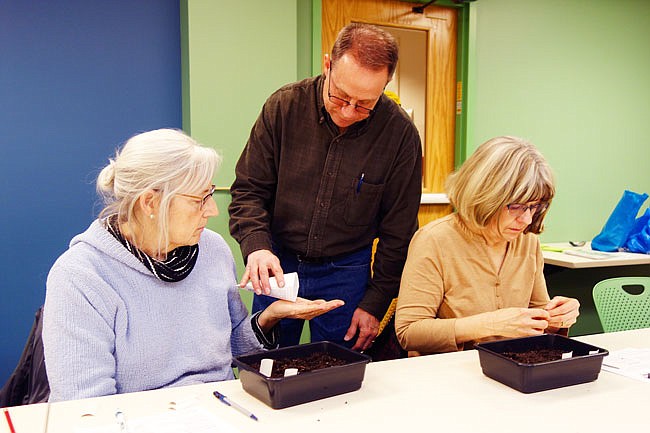Master Gardener Peter Sutter has dirt everywhere this time of year.
There might be trays atop the refrigerator, on window sills and under shop lights. Each shallow tray holds a promise: A little work now means a bounty of vegetables later. That's right: It's seed-starting time.
On Tuesday, Sutter taught a class on how and when to start seeds indoors. He said the practice has advantages to purchasing ready-grown plants.
"When you buy plants, you get what they give you," he said.
The plants found in stores tend to be varieties that grow quickly and easily, and travel well. That's good for the producer's profit margins but not necessarily for the average gardener. For more exotic, unusual and heirloom varieties, it's best to look to seed packets.
"You can buy seeds locally when they become available," Sutter said. "The garden centers locally will sell the seeds they know grow well here."
All winter long, seed catalogues brim-full of tempting pictures - gleaming tomatoes, pendulous cucumbers - have been arriving in mailboxes across the nation. It's easy to shop by sight, but that's a trap, Sutter said.
"If you order from a catalogue, you have to know what you're doing," he said.
The U.S. is divvied up into hardiness zones: geographical areas with certain climate conditions. (Callaway County, for example, is in zone 6A.) Plants produce better results in certain areas. Sutter advised bearing in mind hardiness zones and ripening times when seed shopping.
"If you grow a 60-day cabbage here, it'll be fine," Sutter said. "A 100-day cabbage will ripen in late summer, and it'll be bitter because it's too hot."
After selecting seeds, your next step is determining the proper time to plant. These tables from the University of Missouri Extension make that easy to do: extension2.missouri.edu/g6570. For example, peppers, eggplants and tomato are best started in March.
Next, acquire your materials. You'll want shallow trays or small pots, seed-starting potting mix (preferable because it's finer and sterile; note that some brands will need to be fertilized), labels and a good light source. Sutter uses a fluorescent shop light, positioned 2-4 inches above the soil with the help of chains or stacked boards - he moves the light up, or the plants down, as the plants grow. A south-facing window will also do. A source of warmth, such as heating pads, will help jump-start the process.
Pre-dampen the soil, then portion out into your containers, packing lightly. Plant your seeds at the depth recommended on the packet - some seeds, like celery, onions and lettuce, need light exposure to grow. Other seeds need special treatment, like soaking or roughing up with a file; the packet should contain that information as well.
Keep damp and check frequently. Seeds grown in trays will need to be given their own pots once the second pair of leaves grow.
Providing sufficient light is key. Light-starved plants will shoot up unsustainably fast, becoming "leggy" and weak.
"Once it gets leggy, it's done for," Sutter noted.
Plants' stems can be strengthened by simulating wind, either with a fan (re-positioned regularly) or daily, gentle brushes with your hand.
"Do you pet your cats? You should pet your plants too, or they'll get jealous," Sutter said.
Once the young plants are well-established and outdoor conditions are suitable - more info from the Extension on determining the right date can be found here: extension2.missouri.edu/g6201 - they'll need to be hardened. That's the gardening term for gradually transitioning the plants to outdoor living.
"You want to break them in gradually to everything: the sun, the wind, the cold," Sutter said.
He suggests setting them out on a warm, cloudy day, and bringing them in at nightfall. He's got a favored spot under his porch that allows in gentle morning sun while protecting fragile plants from the elements. Gradually expose the plants to more and more sunlight over the course of a week to 10 days.
Then, it's time to wish your plants well and put them in the ground.

